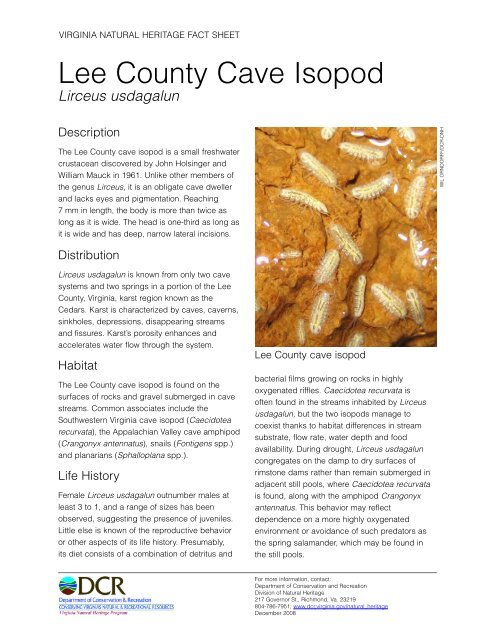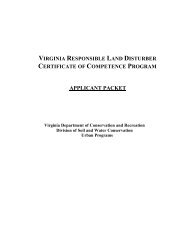Lee County Cave Isopod - Virginia Department of Conservation and ...
Lee County Cave Isopod - Virginia Department of Conservation and ...
Lee County Cave Isopod - Virginia Department of Conservation and ...
Create successful ePaper yourself
Turn your PDF publications into a flip-book with our unique Google optimized e-Paper software.
VIRGINIA NATURAL HERITAGE FACT SHEET<br />
<strong>Lee</strong> <strong>County</strong> <strong>Cave</strong> <strong>Isopod</strong><br />
Lirceus usdagalun<br />
Description<br />
The <strong>Lee</strong> <strong>County</strong> cave isopod is a small freshwater<br />
crustacean discovered by John Holsinger <strong>and</strong><br />
William Mauck in 1961. Unlike other members <strong>of</strong><br />
the genus Lirceus, it is an obligate cave dweller<br />
<strong>and</strong> lacks eyes <strong>and</strong> pigmentation. Reaching<br />
7 mm in length, the body is more than twice as<br />
long as it is wide. The head is one-third as long as<br />
it is wide <strong>and</strong> has deep, narrow lateral incisions.<br />
Distribution<br />
Lirceus usdagalun is known from only two cave<br />
systems <strong>and</strong> two springs in a portion <strong>of</strong> the <strong>Lee</strong><br />
<strong>County</strong>, <strong>Virginia</strong>, karst region known as the<br />
Cedars. Karst is characterized by caves, caverns,<br />
sinkholes, depressions, disappearing streams<br />
<strong>and</strong> fissures. Karst’s porosity enhances <strong>and</strong><br />
accelerates water flow through the system.<br />
Habitat<br />
The <strong>Lee</strong> <strong>County</strong> cave isopod is found on the<br />
surfaces <strong>of</strong> rocks <strong>and</strong> gravel submerged in cave<br />
streams. Common associates include the<br />
Southwestern <strong>Virginia</strong> cave isopod (Caecidotea<br />
recurvata), the Appalachian Valley cave amphipod<br />
(Crangonyx antennatus), snails (Fontigens spp.)<br />
<strong>and</strong> planarians (Sphalloplana spp.).<br />
Life History<br />
Female Lirceus usdagalun outnumber males at<br />
least 3 to 1, <strong>and</strong> a range <strong>of</strong> sizes has been<br />
observed, suggesting the presence <strong>of</strong> juveniles.<br />
Little else is known <strong>of</strong> the reproductive behavior<br />
or other aspects <strong>of</strong> its life history. Presumably,<br />
its diet consists <strong>of</strong> a combination <strong>of</strong> detritus <strong>and</strong><br />
<strong>Lee</strong> <strong>County</strong> cave isopod<br />
bacterial films growing on rocks in highly<br />
oxygenated riffles. Caecidotea recurvata is<br />
<strong>of</strong>ten found in the streams inhabited by Lirceus<br />
usdagalun, but the two isopods manage to<br />
coexist thanks to habitat differences in stream<br />
substrate, flow rate, water depth <strong>and</strong> food<br />
availability. During drought, Lirceus usdagalun<br />
congregates on the damp to dry surfaces <strong>of</strong><br />
rimstone dams rather than remain submerged in<br />
adjacent still pools, where Caecidotea recurvata<br />
is found, along with the amphipod Crangonyx<br />
antennatus. This behavior may reflect<br />
dependence on a more highly oxygenated<br />
environment or avoidance <strong>of</strong> such predators as<br />
the spring salam<strong>and</strong>er, which may be found in<br />
the still pools.<br />
For more information, contact:<br />
<strong>Department</strong> <strong>of</strong> <strong>Conservation</strong> <strong>and</strong> Recreation<br />
Division <strong>of</strong> Natural Heritage<br />
217 Governor St., Richmond, Va. 23219<br />
804-786-7951; www.dcr.virginia.gov/natural_heritage<br />
December 2008<br />
WIL ORNDORFF/DCR-DNH
Threats <strong>and</strong> <strong>Conservation</strong><br />
In 1987, leachate from a sawmill heavily polluted<br />
the stream <strong>of</strong> one cave inhabited by the <strong>Lee</strong><br />
<strong>County</strong> cave isopod. The level <strong>of</strong> dissolved<br />
oxygen in that stream diminished to a point that<br />
all life in the stream was eliminated. By November<br />
2001, the fauna was making a notable recovery,<br />
<strong>and</strong> by February 2002, staff <strong>of</strong> the Division <strong>of</strong><br />
Natural Heritage <strong>of</strong> the <strong>Virginia</strong> <strong>Department</strong> <strong>of</strong><br />
<strong>Conservation</strong> <strong>and</strong> Recreation <strong>and</strong> <strong>of</strong> the U.S. Fish<br />
<strong>and</strong> Wildlife Service found that the isopod had<br />
recolonized that cave, possibly having taken<br />
refuge in uncontaminated reaches upstream<br />
following the 1987 incident.<br />
In addition to water quality degradation, threats<br />
to the isopod include the use <strong>of</strong> sinkholes as<br />
disposal sites for household, industrial <strong>and</strong><br />
agricultural wastes, nonpoint-source pollution,<br />
failing septic tanks, toxic spills, <strong>and</strong> improper<br />
development on or near key karst areas.<br />
In 1992, the <strong>Lee</strong> <strong>County</strong> cave isopod was listed<br />
as endangered. The species is considered both<br />
globally <strong>and</strong> state imperiled due to its extremely<br />
small range <strong>and</strong> small population.<br />
In 1997, a recovery plan was written to increase<br />
the viability <strong>of</strong> Lirceus usdagalun <strong>and</strong> eventually<br />
have it removed from the endangered species<br />
list. Numerous partnerships were developed to<br />
implement the plan.<br />
The Cedars, an area <strong>of</strong> more than 30 square<br />
miles, has been designated a Natural Area<br />
Preserve <strong>and</strong> is owned by the Division <strong>of</strong> Natural<br />
Heritage. The Cedars Natural Area Preserve is<br />
also a haven for many rare plant species.<br />
<strong>Virginia</strong> Natural Heritage<br />
The <strong>Virginia</strong> <strong>Department</strong> <strong>of</strong> <strong>Conservation</strong> <strong>and</strong><br />
Recreation’s Division <strong>of</strong> Natural Heritage<br />
maintains a database <strong>of</strong> rare species, populations<br />
<strong>and</strong> natural communities in the commonwealth,<br />
<strong>and</strong> manages the State natural Area Preserve<br />
System. Natural Heritage biologists, stewardship,<br />
<strong>and</strong> protection staff can answer l<strong>and</strong>owners’<br />
questions about rare species <strong>and</strong> sensitive<br />
habitats. The staff also provides information <strong>and</strong><br />
expertise on conservation <strong>and</strong> management<br />
practices that help ensure that we preserve our<br />
rich natural heritage <strong>and</strong> pass it on to future<br />
<strong>Virginia</strong>ns.<br />
To learn more about <strong>Virginia</strong>’s rare plant <strong>and</strong><br />
animal species <strong>and</strong> rich biological communities,<br />
visit the website <strong>of</strong> the Division <strong>of</strong> Natural Heritage,<br />
at www.dcr.virginia.gov/natural_heritage<br />
For additional information on the <strong>Lee</strong> <strong>County</strong> cave isopod,<br />
see NatureServe Explorer: Lirceus usdagalun<br />
Special thanks to the Riverine Chapter <strong>of</strong> the <strong>Virginia</strong><br />
Master Naturalist Program for its assistance in developing<br />
this fact sheet.
















